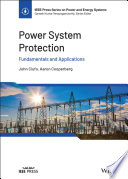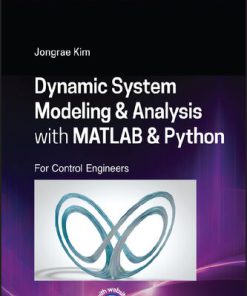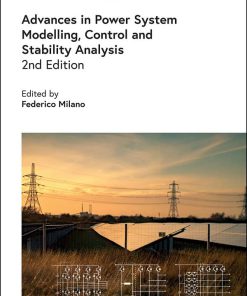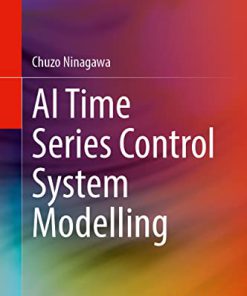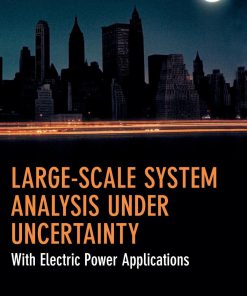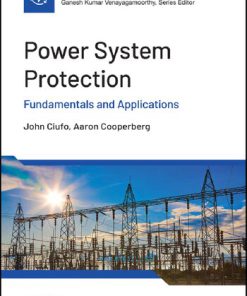Power System Transients : Modelling Simulation and Applications 1st Edition by Gevork Gharehpetian 9781000825763 1000825760
$50.00 Original price was: $50.00.$25.00Current price is: $25.00.
Power System Transients : Modelling Simulation and Applications 1st Edition Gevork Gharehpetian – Ebook Instant Download/Delivery ISBN(s): 9781000825763, 1000825760
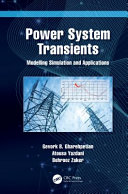
Product details:
- ISBN 10:1000825760
- ISBN 13:9781000825763
- Author: Gevork Gharehpetian
Power System Transients
Modelling Simulation and Applications
Table contents:
1 Overview
1.1 Introduction
1.2 Categories of Transient Phenomenon in Power Systems
1.3 Transients and Their Effect on Design and Operation of Power Systems
1.4 Catastrophic Cases
1.4.1 High Voltage Transients
1.5 Overcurrent Transients
1.5.1 Circuit Breaker Design
1.5.2 Mechanical Stress
1.5.3 Thermal Stress
1.6 Abnormal Waveforms
1.6.1 Importance of the Study
1.7 Electromechanical Transients
1.8 Study Techniques for Transient Studies
1.8.1 Modeling and Simulation
1.8.2 Simulations Tools
1.8.3 Important Considerations for Transient Analysis
1.9 An Introduction to PSCAD/EMTDC
Bibliography
2 Traveling Waves
2.1 Transmission Line Equations
2.1.1 Lossless Lines
2.1.2 Lossy Lines
2.2 Reflection Rules for Sinusoidal Waves
2.2.1 Transmission Line Reflection
2.2.2 End of the Line Reflection
2.2.3 Reflection at the Beginning of the Line
2.2.4 Voltage Distribution across a Lossless Line
2.2.5 Frequency-dependent Wave Speed Propagation Variation
2.2.6 Frequency-dependent Characteristic Impedance Variations
2.3 Step-form Traveling Waves
2.3.1 Solving Equations
2.3.2 Current Equations (D’Alembert’s Solution)
2.3.3 Forward and Backward Waves
2.3.4 Reflection Rules for Step Waves
2.3.5 Loss Consideration in Line
2.4 PSCAD Examples
Bibliography
3 Lattice Diagram and Its Applications
3.1 Traveling Wave as a Function of Time and Location
3.2 Cable Connection to Transmission Line
3.3 Closing Resistance Circuit Breakers
3.3.1 Source Internal Resistance
3.3.2 Dead Line Connection to Live Line
3.4 Reflection in Branches
3.5 Special Cases in Reflection
3.5.1 Capacitor Connection at the End of the Line
3.5.2 Inductors Connection at the End of the Line
3.5.3 Parallel LC Connection at the End of the Line
3.5.4 Series LC Connection at the End of the Line
3.5.5 Combination of Inductors and Capacitors in the Middle of the Line
3.6 PSCAD Examples
3.6.1 Overhead Line and Cable Connection
3.7 Closing Breaker in Line Energization
3.8 Capacitor Connection at the End of the Line
3.9 Inductor Connection at the End of the Line
3.10 Parallel Filter LC Connection at the End of the Line
Bibliography
4 Lightning-Induced Transients
4.1 Introduction
4.2 General Characteristics of Lightning Surges
4.3 Types of Stroke
4.3.1 Direct Stroke to Phase Conductor
4.3.2 Ground Conductor or Tower Stroke
4.3.3 Nearby Strokes
4.4 System Response to Voltage Arbitrary Pulses
4.5 Application of Lattice Diagram
4.6 Tower Modeling for Transient Studies
4.7 PSCAD Examples
Bibliography
5 Energization Overvoltages
5.1 Source-type Effect
5.1.1 Step Source Energization through Inductance
5.1.2 Sinusoidal Source Energization through Inductance
5.1.3 Line Energization through Energized Lines
5.1.4 Source Energization through Inductance Adjacent to Parallel Lines
5.2 Asynchronous Closing of Three Phase Circuit Breaker Contactors
5.3 Reactive Compensation
5.4 Trapped Charge
5.5 System Losses
5.6 Switching Location
5.7 Terminal Type of Effects
5.8 Capacitive Bank Closing
5.9 PSCAD Examples
5.9.1 Sinusoidal Source Energization through Inductance
5.9.2 Source Energization through Inductance Adjacent to Parallel Lines
5.9.3 Terminal-type Effects
Bibliography
6 Transients Induced by De-energization
6.1 Transient Recovery Voltages
6.2 Rate of Rise of Recovery Voltage
6.3 Current Injection Methodology
6.4 Factors Affecting Transient Recovery Voltages
6.4.1 Power Factor Effect on Transient Recovery Voltages
6.4.2 Natural Frequency Effect on Transient Recovery Voltages
6.4.3 Effect of Existence of Two Natural Frequencies on Transient Recovery Voltages
6.4.4 Damping Effect on Transient Recovery Voltages
6.4.5 Effect of Type of Short Circuit
6.4.6 Arc Voltage Effect on TRV
6.5 Fault Interruption in a Short Line
6.6 Magnetizing Current Chopping
6.7 Residual Flux Effect on Transformer Inrush Current
6.8 Capacitive Current Interruption
6.9 Disconnectors Opening
6.10 PSCAD Examples
6.10.1 Transient Recovery Voltages
6.10.2 Effect of Existence of Two Natural Frequencies on Transient Recovery Voltage
6.10.3 Magnetizing Current Chopping
Bibliography
7 Traveling Wave Influence on Power Transformers Windings
7.1 Winding Modeling without Mutual Inductances
7.1.1 Voltage Initial Distribution
7.1.2 Equivalent Capacitance of the Winding at t = 0
7.1.3 Final Distribution
7.1.4 Solution for Main Partial Differential Equation
7.1.5 Traveling Wave Response Justification
7.2 Winding Modeling with Mutual Coupling and Resistances
7.2.1 Winding Detailed Model
7.3 MATLAB®/Simulink® Example
Bibliography
8 Ferroresonance
8.1 Linear Circuit Resonance
8.2 Nonlinear Circuit Resonance
8.2.1 Stability Assessment of Operating Points in a Nonlinear Resonance Circuit
8.3 Ferroresonance Practical Cases in Power Systems
8.3.1 One Phase Open
8.3.2 Overload Relay Malfunction
8.3.3 De-energization of One Circuit of Two-circuit Transmission Line
8.3.4 Single-Phase Fault and Capacitive Voltage Transformer
8.4 Simulations
People also search:
power system transients : modelling simulation and applications
power system transients modelling simulation and applications
power system transients modelling simulation and applications pdf
You may also like…
Instruments & Measurements
Engineering - Electrical & Electronic Engineering
Computers - Computers - General & Miscellaneous
Dynamic System Modelling and Analysis with MATLAB and Python 1st Edition Jongrae Kim
Uncategorized
Engineering - Energy & Power Resources
Advances in Power System Modelling, Control and Stability Analysis 2nd Edition Federico Milano
Computers - Artificial Intelligence (AI)
Engineering - Electrical & Electronic Engineering
Engineering - Electrical & Electronic Engineering
Power System Protection Fundamentals and Applications 1st Edition John Ciufo Aaron Cooperberg




